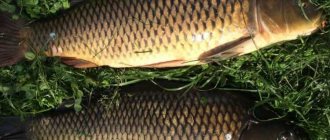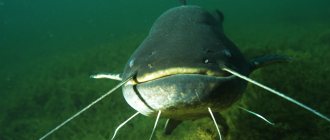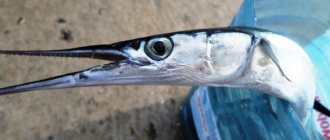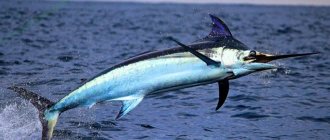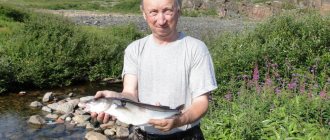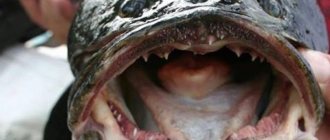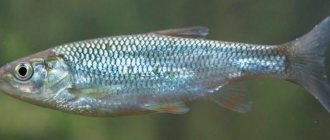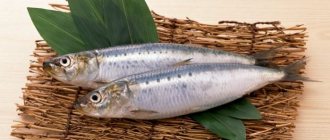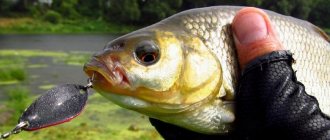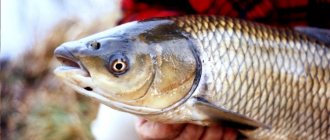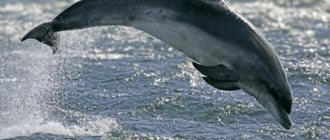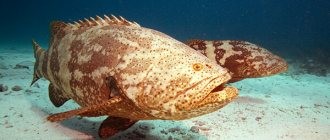Chinook salmon is a very beautiful and large fish. She has a rather large head and a torpedo-shaped body. When the fish is in the sea, it does not catch the eye. She has a dark back with a greenish olive tint. The sides and belly are cast in silver. A characteristic distinguishing feature of the fish are small dark spots on the lateral surfaces of the body and fins. No less characteristic is the dark stripe at the transition from the body to the head.
When an individual arrives in the river, following the path to the spawning site, it acquires its colorful nuptial plumage . This change in appearance is a feature of all representatives of the salmon family. The body of this sea creature takes on a reddish-brown tint, and the back becomes almost black. The transverse stripes on the back disappear. In this case, there is no change in body proportions. There may be some curvature of the jaws in males and the appearance of teeth in both sexes.
Compared to other representatives of the salmon family - chum salmon or pink salmon - the mating color of this species does not look so bright and expressive. Small juveniles are very easy to confuse with coho salmon. Distinctive features are dark spots on the back and black gums of the lower jaw.
Description
| Class: | Ray-finned fish |
| Squad: | Salmonidae |
| Family: | Salmonidae |
| Genus: | Pacific salmon |
| View: | Chinook |
| Scientific name: | Oncorhynchus tshawytscha |
Fish from the Salmon family has long been known to Kamchadals as a delicacy. The first description of Chinook salmon in Kamchatka during an expedition in 1701 was made by the Yakut Cossack Vladimir Atlasov, and 90 years later, information about the fish was presented to the scientific community by the German naturalist Johann Walbaum.
There are Far Eastern (Kamchatka), American, Asian and Alaskan Chinook salmon.
The scarce Far Eastern salmon is listed in the Red Book of the Russian Federation; its catch is permitted within certain periods in a limited volume. As a prey item, Chinook salmon attracts athletes and amateur fishermen due to the difficulties with fishing. Fishermen are interested in catching king salmon with excellent gastronomic qualities due to high demand in the market.
The life of Chinook salmon is divided into 3 phases:
- The fry develop in fresh water.
- At the age of four months to two years, the juveniles move to the sea, where they fatten up.
- The third phase is the return to the rivers for spawning, death 7–14 days after the reproduction of the offspring.
What does Chinook salmon look like?
You can see what the Far Eastern Chinook salmon looks like in the photo. The body of the salmon is powerful, reminiscent of a torpedo. On the disproportionately huge head there is a large mouth with a black lower jaw, and small eyes.
In the photo: Chinook fish
The color of the fish is unstable and depends on the phase of life:
- During growth and fattening, the small rounded scales are colored silver on the sides, belly and olive on the back.
- Small black spots are evenly distributed on the upper part of the body, on the tail, and fins.
- During the spawning period, the back of males becomes almost black, the rest of the body becomes red-brown. In addition, their jaws become curved and their teeth increase in size.
- Females do not change color during spawning.
Special characteristics of the species: - dark stripes at the junction of the body and head; — 15 gill rays; - 2 dorsal fins; - pelvic fins directed towards the tail.
Chinook salmon filleting
It is more convenient to cut large fish with a special long knife with a flexible blade. First, a longitudinal incision is made in the abdomen and all the insides are removed. In this case, you should not touch the gallbladder with a knife. Its contents have a bad effect on taste.
The head and fins are removed according to the following rules:
- the head is taken in the hand and trimmed along the line of the gill plates;
- the gills give off a bitter taste and are therefore removed;
- The fins and tail are cut off with a small sharp blade.
To get rid of bones, the spine is cut off on both sides, the blade is drawn starting from the back and moving towards the tail. Then the ribs are removed and the meat is cut off.
To remove the skin, place the fish on a cutting board, meat side up. Remove some fillet from near the tail. Grab the loose skin with your fingers, press it with a knife and pull the blade away from you. A sharp knife will easily separate the fillet from the skin, but it should be firmly pressed against the cutting board.
Differences from coho salmon
Small king salmon are distinguished from coho salmon by the presence of black gums on the lower jaw, small black spots in the spine area and on the fins.
Chinook salmon on the left, coho salmon on the right
On the body of chinook salmon there are no signs of other types of red fish - pink spots, stripes running along the body.
Chinook salmon habitats
Information about where Far Eastern chinook salmon is found is relevant for fishermen who prefer large fish. In May-June, having fattened up, salmon enter the rivers from the sea and live in the lower reaches of the reservoir, in the estuary.
The fish feels comfortable among snags and chooses deep places with uneven topography of a rocky bottom or a bottom overgrown with aquatic vegetation.
When the food supply dries up, king salmon rush to the sea. Fish can be found both in bays and in the open ocean a thousand kilometers from the coastline.
Preparation:
Every third recipe says that before salting fish, you should not wash it. The salting technology is really based on replacing plain water with salt water (2-3%), because... plain water is a medium for the spread of bacteria, which is highly undesirable when salting. But if we decide to salt fish at home, this can be neglected. Especially if you have a whole carcass, you definitely need to wash it and you shouldn’t be afraid of anything.
If the fish is gutted, you can wash the inside with a weak saline solution at room temperature, then let the water drain and wipe dry with dry gauze (rag). Personally, I wash my house under simple running water and in 15 years I have never had any problems associated with this. The main thing is not to wash it in warm water, because... this will have a detrimental effect on the taste.
What does it eat?
Before going to sea, Chinook salmon fry and juveniles feed on zooplankton, caddisfly larvae, and stoneflies. Sexually mature individuals in freshwater bodies feed on crustaceans, small fish, insects, and caviar. The diet of king salmon living in seawater includes:
- juvenile silverfish, capelin, gobies, herring, sand lance, pollock;
- squid;
- shrimps;
- jellyfish;
- pteropods:
- crustacean larvae.
The greatest feeding activity in Chinook salmon was observed during the daytime, since salmon use their eyesight when hunting. The daily diet varies depending on seasonality, on average 5–10% of the fish’s weight.
Quality of river fish
Despite the fact that water has a certain density, the body of the fish is ideally suited for movement in such conditions. And this applies not only to river fish, but also to sea fish.
Typically, its body has an elongated, torpedo-like body shape. In extreme cases, its body has a spindle-shaped shape, which facilitates unhindered movement in the water. Such fish include salmon, podust, chub, asp, sabrefish, herring, etc. In still water, most fish have a flat body, flattened on both sides. Such fish include crucian carp, bream, rudd, roach, etc.
Among the many species of river fish there are both peaceful fish and real predators. They are distinguished by the presence of sharp teeth and a wide mouth, which allows them to swallow fish and other living creatures without much difficulty. Similar fish include pike, burbot, catfish, pike perch, perch and others. A predator such as a pike is capable of developing enormous initial speed during an attack. In other words, it literally swallows its prey instantly. Predators such as perch always hunt in schools. Pike perch leads a bottom-dwelling lifestyle and begins hunting only at night. This indicates his uniqueness, or rather his unique vision. He is able to see his prey in complete darkness.
But there are also small predators that do not have large mouths. Although, such a predator as the asp does not have a huge mouth, such as a catfish, for example, and it feeds only on young fish.
Many fish, depending on their habitat conditions, can have different shades. In addition, different reservoirs may have different food supplies, which can significantly affect the size of the fish.
It will be interesting: Chebak fish (Siberian roach) what kind of fish is it - description and photo
Life period and spawning characteristics
The spawning of Far Eastern salmon lasts all summer. After a seven-year stay in sea water, females and males rush into the rivers where they themselves were born.
Strong fish are not afraid of natural enemies, obstacles and currents. Overcoming difficulties, they cover a distance of up to 4 thousand kilometers to get to their native places. Salmon swim upstream in huge schools, filling the entire width of the channel, without being distracted by feeding. At this time, Chinook salmon are easy prey for otters, bears, and humans.
Having reached the goal, the females use their powerful tails to dig spawning holes among large pebbles and stones. 5–10 males circle around them, ready to fertilize a clutch consisting of 10–15 thousand large eggs. Most of the laid eggs are carried away by the current and eaten by other fish.
Among the males there are dwarf specimens of 35-40 cm (kayurki), which have spent their entire lives in the river or coastal zone, without going to sea. It has been proven that such males do not “spoil” their offspring - the new generation can grow to gigantic sizes.
After reproduction of offspring, due to high energy expenditure and hormonal changes, females and males soon die.
Beneficial features
The nutritional value of Chinook salmon is high. At the same time, its usefulness surpassed all other sea fish.
- Firstly, it is rich in protein: 100 grams contain as much as 20 grams. squirrel. It can more than become an element of dietary nutrition, since the percentage of fat in it is significantly less than other salmon.
- Secondly, Chinook salmon contains all the vitamins and microelements necessary for the body. Its regular consumption can reduce the risk of dangerous diseases (heart failure, strokes, depression and much more).
- Thirdly, it normalizes the functioning of the brain (which is especially important for people whose work is associated with active mental activity) and internal organs, and also prevents the appearance and development of quite serious diseases.
Such fish is a real vitamin “boom”. It is not surprising that its use is recommended by all experts. In its meat you can find:
- vitamins A, B, C, E, K
- copper
- zinc
- manganese
- magnesium
- iron
- phosphorus
- potassium
In addition, Chinook salmon caviar can improve vision, improve blood circulation, as well as strengthen bone tissue and reduce the risk of blood clots.
There are no serious contraindications to eating fish. These include only individual intolerance to meat or an allergic reaction to caviar. People suffering from diseases of the gastrointestinal tract should be wary of Chinook salmon.
You should also not abuse it. Despite all the benefits, a large amount of fish every day can cause deterioration of digestive processes.
Chinook salmon is not a cheap fish, but it won’t hurt to dilute your usual daily diet at least once a month. The body will say a huge “thank you” for this by improving the functioning of the immune system.
Population and species status
Industrial and poaching of king salmon has led to a significant decline in the population and the extinction of the species in some Far Eastern rivers. If 50 years ago fisheries received quotas for Chinook salmon production in the amount of 50 thousand tons, then in recent years the volume of permitted catch has decreased to two hundred tons.
The administration of the Kamchatka Territory has taken a number of measures to reproduce delicious salmon. There is a Malkinsky fish hatchery that breeds and releases juveniles into their natural habitat.
Measures to combat poachers have been tightened.
The Commission for the Regulation of Catch of Anadromous Fish Species annually:
- sets catch volumes;
- distributes them to specific objects;
- determines the dates of passing days when salmon fishing is permitted and prohibited;
- gives recommendations on the boundaries of the installation of fishing gear, the size of net meshes, and the reporting of legal entities.
Industrial and recreational fishing is prohibited on the Kuril Islands, Paratunka, Avacha Bay, and West Kamchatka subzone. Despite this, due to poaching, the number of the species continues to decline, although thanks to rapid reproduction, the population can be restored to previous values within 10 years.
Where does it live?
The main habitat is in the cool western and eastern waters of the Pacific Ocean. It is found off the northern coasts of America, Canada and, thanks to artificial breeding, in New Zealand. In Russia, “wild salmon” can be found:
- in the Far East,
- off the coast of Kamchatka,
- in Chukotka,
- on the Commander Islands,
- in the Barents and Okhotsk seas,
- in the northeastern part of Siberia, only the Asian variety is found.
Yandex.Pictures
Features of fishing - where, how and what to catch Chinook salmon
The following Kamchatka rivers are considered suitable for recreational fishing: Kol, Bolshaya, Kolpakova, Pymta and their tributaries.
King salmon is the most desirable fishing object due to its gigantic size, secrecy, and caution. The fish choose hard-to-reach parking spots, taking care of their safety, which makes it difficult to bite. The rivers of Kamchatka are not suitable for fishing from the shore. Due to the high current, they are washed away and cluttered with fallen trees and bushes. Chinook salmon are mainly caught in shallow water or from a motor boat in open areas.
Daytime stops for Kamchatka salmon are places of narrowing curved reaches in the deepest parts of the bottom, flow-through pits with whirlpools at the junction of the channel with a side channel, and low-flow pits near the main channel.
Fly fishing gear with flies does not work well. The seething current throws the bait to the surface and prevents normal fishing. To catch Chinook salmon, you need a powerful, rigid spinning rod of medium action, equipped with a large inertia-free reel and a cord with a load of 25–30 kg.
As bait they use spinners, spinners with their own game, wobblers in blue shades or combinations of pink and white colors. For fishing in deep holes, wobblers of acidic colors are chosen.
A universal bait for Kamchatka fishing is a spinner with a silver petal Mepps Aglia Long No. 3 and No. 4.
From a motor boat, fish are caught by trolling, when the bait, thrown to a certain depth, is moved by the driving force of the motor. When catching elk in holes with a seething current, they use bait casting and a simple, slow winding of the cord. The spoon moves with water vortices in different directions, which ensures a bite. Since the Chinook salmon does not swallow the bait, the hook is done abruptly.
Chemical composition and nutritional value
The gastronomic value of dietary meat lies in its delicious taste, dense structure that holds its shape, and the ability to prepare various dishes.
Energy value of 100 g of product: - 148 kcal; — BJU (proteins, fats, carbohydrates): 19, 8 and 0.
The beneficial properties of fish meat are determined by its chemical composition. Table of nutrients contained in Chinook salmon:
| Nutrient group | Name | % of daily value per 100 g of product |
| Vitamins: | Calciferol | 200 |
| A nicotinic acid | 53 | |
| Cobalamin | 43 | |
| Kholin | 18 | |
| Pantothenic acid | 15 | |
| Pyridoxine | 14 | |
| Alpha tocopherol | 11 | |
| Riboflavin | 7 | |
| Thiamine | 7 | |
| Unsaturated fatty acids: | Omega-3 | 100 |
| Omega-6 | 6 | |
| Microelements: | Chromium | 110 |
| Selenium | 66 | |
| Fluorine | 11 | |
| Zinc | 6 | |
| Molybdenum | 6 | |
| Copper | 4 | |
| Iron | 4 | |
| Phosphorus | 25 | |
| Sulfur | 20 | |
| Potassium | 16 | |
| Chlorine | 7 | |
| Magnesium | 7 |
Delicacy salmon is a dietary product. Its low-calorie meat does not contain trans fats, starch, natural sugars, or fiber. Fats are mostly represented by polyunsaturated acids. The value of saturated fat is minimal (2 g per 100 g of product).
Chinook caviar
The red eggs reach 7 mm in diameter. Tender, slightly bitter chinook caviar is the most expensive and rare of all salmon species.
Pictured: Chinook salmon caviar
The calorie content of 100 g of product is 263 kcal.
The delicacy is consumed in limited quantities due to the excess amount of sodium, the content of which is 2.5 times more than the daily norm.
The benefits and harms of Chinook salmon
Beneficial properties of king salmon meat:
• improves the synthesis of phospholipids in the liver: • strengthens the musculoskeletal system; • delays dementia, Alzheimer's disease; • activates brain activity; • participates in hematopoiesis, synthesis of hemoglobin, hormones; • strengthens immune defense; • normalizes protein, lipid, carbohydrate metabolism; • prevents osteoporosis, arthritis, atherosclerosis, heart failure, thrombus formation; • reduces the risk of vascular accidents; • supports the functioning of the adrenal glands, the health of the skin and mucous membranes; • smoothes out the effects of stress; • prevents visual impairment.
— Salmon is recommended to be consumed with caution by pregnant women and people prone to allergies. Especially a lot of mercury and other harmful substances accumulate in large specimens. — Fried, salted chinook salmon is contraindicated for diseases of the pancreas, inflammation of the gallbladder, colitis, enteritis.
The benefits of Chinook salmon for humans.
Fish contains many elements beneficial to humans, but they depend on various factors. For example, one can cite habitat and age; gender also matters.
But despite this, there are certain permanent vitamins. The main ones are calcium (22 mg), copper (41 mcg), phosphorus (200 mg), magnesium (27 mg), potassium (394 mg), etc. Omega-3 acids are present.
The main feature of fish is that the fats are unsaturated, that is, they will not be stored as excess weight. Chinook salmon contains selenium, which slows down the aging process in the body. One 100g serving contains 148 calories, caviar contains 250.
Chinook salmon has the property of preventing heart attacks and strokes. Caviar helps improve vision and bone tissue.
Use in cooking
The exquisite taste of king salmon satisfies even the most demanding gourmets. At retail outlets, customers are offered frozen fish, chilled in carcasses with and without heads, cut into steaks and fillets. Canned red fish is used to prepare salads.
Chinook salmon is used to make fish soup, soups, and steamed fish. Delicious salmon is eaten boiled, fried, baked, or stewed.
- It is especially tasty when lightly salted; gourmets appreciate balyk.
- Heat-treated Chinook salmon is served as a separate dish, with a side dish of vegetables, cereals, and mushrooms.
- Delicious nutritious salads, snacks, sandwiches, and rolls are made with salmon.
- The festive table will be decorated with fish stuffed with vegetables.
How much does 1 kg of Chinook salmon cost?
On average, prices for this fish fall into the following ranges:
- large chilled steak - 1300-1500 rubles / kg;
- fresh frozen carcass with head - 400-500 rubles / kg;
- fresh frozen carcass without head - 700 rubles / kg;
- chilled fillet - 1300-1500 rubles / kg;
- Chinook caviar - 5000-6000 rubles / kg.
Recipes
In order for Chinook salmon dishes to turn out tasty and healthy after frying, baking, stewing, or salting, you should follow the ratio of ingredients and follow the cooking recommendations indicated in the recipes.
Chinook salmon fried in a frying pan
To fry a couple of steaks you will need 2 tablespoons of vegetable oil, 30 g of flour, salt and pepper to taste.
Seasonings are poured into flour, steaks dried with a paper towel are rolled in it. Shake off excess flour and place in a frying pan with heated oil. Fry the steaks on a high, but not maximum, heat for 7 minutes on each side.
The taste of fried salmon is combined with fresh, stewed vegetables, fried potatoes, and boiled rice.
Chinook salmon fried on charcoal
Grilled steaks, unlike meat kebabs, cook faster.
Pieces of salmon are sprinkled with pepper, salt, lemon juice and left for a couple of hours. While the fish is marinating, prepare the coals (there should be no open fire). To give the dish a smoked aroma, alder sprigs are added to the grill.
The prepared pieces are placed on a wire rack. Fry on each side for 6–8 minutes until golden brown. During the cooking process, you need to be prepared for the fact that the fat dripping from the fish may ignite. It is immediately filled with water so that the coals do not go out.
Chinook salmon baked in foil
Royal salmon cooked in the oven is not only tasty, but also healthy. 100 g of fish baked in foil contains more than 30% of the daily protein requirement, 16% fat, Omega-3,6 fatty acids remain unchanged.
To prepare the dish you will need:
- 1 kg Chinook salmon fillet;
- medium-sized lemon;
- 1 tbsp. l. a spoonful of refined olive or sunflower oil;
- 2 tbsp. l. soy sauce;
- salt, basil, white pepper to taste.
Chinook salmon baked in foil
Preparation:
- Portioned pieces weighing 200 g are sprinkled with seasonings.
- Chinook salmon is placed on prepared, cut into squares and greased with oil foil.
- The fish is poured with a mixture of lemon juice and soy sauce. Wrap in foil so that there is no access to air.
- While the preparations are marinating, preheat the oven to 180 degrees.
- The fillet is placed on a baking sheet and placed in the oven. After 20 minutes, open the foil and increase the temperature to 200 °C. After 5 minutes the dish is ready.
Salmon baked in foil is served on the table with lettuce, tomatoes, sweet bell peppers, and cucumbers.
Lightly salted Chinook salmon
To preserve the unique taste of fatty fish, it is prepared by dry salting. The half-frozen carcass is cut into fillets. The head and tail are cut off, the fins, the backbone with bones are removed, and they are cut into pieces.
Ingredients for 5 kg of Chinook salmon:
- 300 g salt;
- 1 tbsp. l. granulated sugar;
- bay leaf, black pepper.
Cooking algorithm:
- Salt, sugar, pepper are combined and mixed.
- Roll each fish steak in the prepared mixture. Chinook salmon with seasonings are placed in a bowl, food container or pan, covered with a lid and cling film.
- The dishes with fish are placed in the cold. After three days, lightly salted, tender chinook salmon is ready to eat.
Cooked fish is added to salads, sandwiches are made with it, and served as an independent dish.
Coho and Chinook salmon
The Chinook salmon would look exactly like a coho salmon, if not for its black lip, large size and spots all over its body. In coho salmon they are only on the back; its head and belly are always red, unlike the silver-olive “Kamchatka”. In Chinook salmon, the barrel “fills up with blush” only during spawning and there are no transverse stripes, more characteristic of coho salmon and other salmonids.
Another significant difference between fish lies in the taste of the meat and the value of related products. Chinook salmon fillet is tastier, more valuable and more expensive, while caviar is larger, higher in calories and has a special pungent taste with bitterness, for which it is highly valued among gourmets.
Interesting fact: The ancestor of salmon was a saber-tooth, and its length was about 3 meters. Unlike its descendants, it was not a predator, but ate like whales, filtering water.
